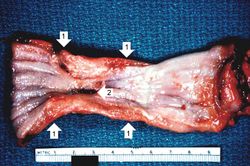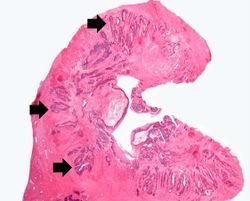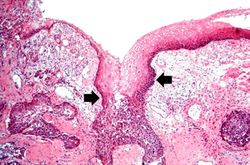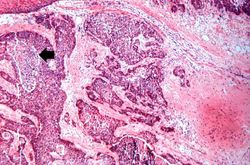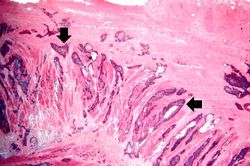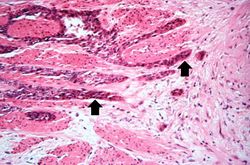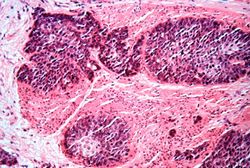Difference between revisions of "IPLab:Lab 7:Esophagus SCC"
Seung Park (talk | contribs) |
Seung Park (talk | contribs) |
||
| Line 29: | Line 29: | ||
* genetic (racial) predisposition.</spoiler> | * genetic (racial) predisposition.</spoiler> | ||
* <spoiler text="What factors facilitate growth and spread of this tumor?">The rich lymphatic network in the submucosa of the esophagus promotes extensive circumferential and longitudinal spread. Intramural tumor cell clusters are often seen several centimeters away from the main tumor mass. Local extension into adjacent mediastinal structures occurs early and often in this disease and seriously limits the chance of curative resection.</spoiler> | * <spoiler text="What factors facilitate growth and spread of this tumor?">The rich lymphatic network in the submucosa of the esophagus promotes extensive circumferential and longitudinal spread. Intramural tumor cell clusters are often seen several centimeters away from the main tumor mass. Local extension into adjacent mediastinal structures occurs early and often in this disease and seriously limits the chance of curative resection.</spoiler> | ||
| + | |||
| + | == Additional Resources == | ||
| + | === Reference === | ||
| + | |||
| + | |||
| + | === Journal Articles === | ||
| + | |||
| + | |||
| + | === Images === | ||
| + | |||
| + | |||
| + | == Related IPLab Cases == | ||
| + | |||
{{IPLab 7}} | {{IPLab 7}} | ||
[[Category: IPLab:Lab 7]] | [[Category: IPLab:Lab 7]] | ||
Revision as of 04:20, 23 August 2013
Contents
Clinical Summary[edit]
Approximately six months prior to admission, this 78-year-old male began having difficulty in swallowing solid food. This difficulty was described as a sticking of the food in his throat and was accompanied by cramping pain which could only be relieved by "coughing up" the ingested food. This dysphagia was accompanied by a twenty-pound weight loss. Following an upper GI series and endoscopic biopsy, the patient was given radiation treatment with considerable improvement. He did well for four months, after which the dysphagia and weight loss increased markedly. He refused operative intervention or further treatment and he died at home two months later.
Autopsy Findings[edit]
An autopsy revealed a circumferential fungating mass in the distal third of the esophagus. This mass partially occluded the lumen of the esophagus.
Images[edit]
Study Questions[edit]
Additional Resources[edit]
Reference[edit]
Journal Articles[edit]
Images[edit]
Related IPLab Cases[edit]
An upper GI series is a series of barium-aided radiographs involving the esophagus, stomach, and duodenum.
